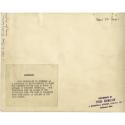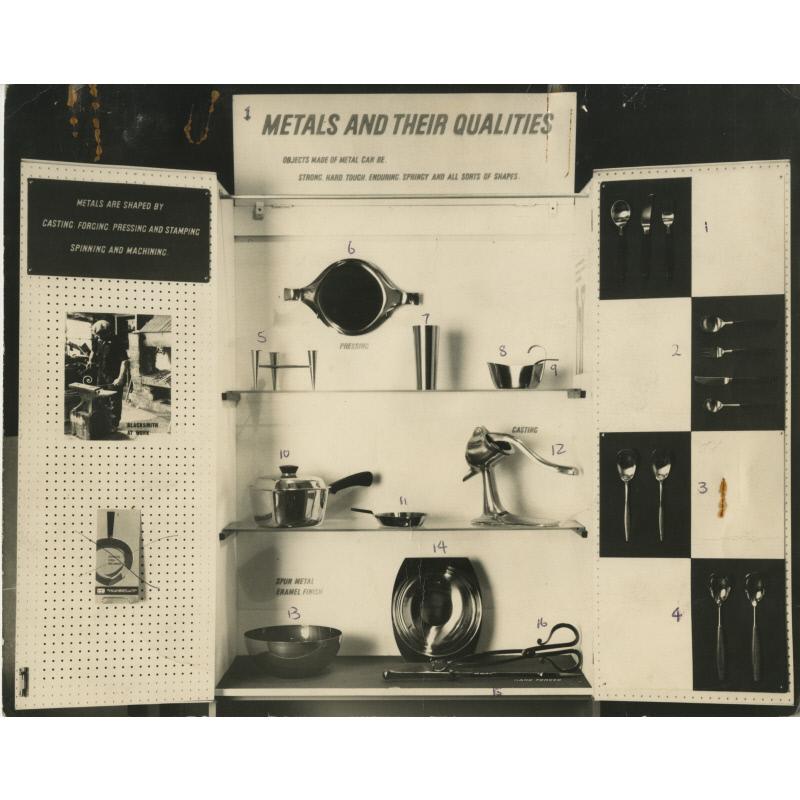Currently indexing
Photograph
Classification(s):
Photograph
Date: c. 1951-1976
Photographer: Tessa Grimshaw
Dimensions:
248 × 198 mm (24.8 × 19.8 cm)
Medium: Black and white photographic print
Object number: IA_M3D_1
See Also
Place of Production:London, England
Title:Metals and their Qualities
DescriptionBlack and white photographic print showing a single display case from the Circulating Design Scheme. The image illustrates the Metals and their Qualities display, featuring case number 1, from group Metal 3D.
Schools taking part in the Circulating Design Scheme received a reference photograph and a record card for each individual case. Reference photographs were used as a visual inventory, allowing the contents of each display to be checked.
The photograph was produced by photographer Tessa Grimshaw in her London Studio.
To the reverse of the print are the case and group number written in pen, additional notes about the items within also written in pen, the photographer’s stamp and an instructional adhesive label.
Schools taking part in the Circulating Design Scheme received a reference photograph and a record card for each individual case. Reference photographs were used as a visual inventory, allowing the contents of each display to be checked.
The photograph was produced by photographer Tessa Grimshaw in her London Studio.
To the reverse of the print are the case and group number written in pen, additional notes about the items within also written in pen, the photographer’s stamp and an instructional adhesive label.
ProvenanceThis item was used in the administration and management of the Inner London Education Authority’s (ILEA) ‘Circulating Design Scheme’.
The Circulating Design Scheme was instigated by the London Country Council (later the Greater London Council) and the Council of Industrial Design (COID). The Scheme’s original purpose was concerned with the teaching and dissemination of modern, ‘good design’ using a collection of art, design and craft-based objects.
The collection was established in 1951/52 as the ‘Experiment in Design Appreciation’, and later renamed the ‘Circulating Design Scheme’.
The Circulating Design Scheme lent boxed showcases to London schools. The showcases contained handling objects, material samples and interpretation on a specific subject.
Schools taking part in the Circulating Design Scheme received a reference photograph and a record card for each individual display case. Reference photographs were used as a visual inventory, allowing the contents of each display to be checked. Record cards capture tour dates and locations, object lists (including stock numbers and descriptions) and supplier information. They were used to transcribe details of the tour programme and record key exhibit information. These materials form a smaller body of archive material which enrich understandings of the objects in the collection, and the history of the Scheme itself.
COID withdrew its involvement in the Scheme in 1957. After which time, it was managed exclusively by the London County Council from 1957-1963.
After the administrative restructuring of London authorities, the Scheme was jointly managed by the Greater London Council and the Inner London Education Authority (ILEA) from 1963 – 1976.
The Scheme was operational until 1976 when the collections were withdrawn from circulation. ILEA was abolished in the late 1980s and the collection was donated to Camberwell College of Arts in 1989/90.
ILEA was responsible for secondary and tertiary education in the inner London boroughs, this included Camberwell.
The Circulating Design Scheme was instigated by the London Country Council (later the Greater London Council) and the Council of Industrial Design (COID). The Scheme’s original purpose was concerned with the teaching and dissemination of modern, ‘good design’ using a collection of art, design and craft-based objects.
The collection was established in 1951/52 as the ‘Experiment in Design Appreciation’, and later renamed the ‘Circulating Design Scheme’.
The Circulating Design Scheme lent boxed showcases to London schools. The showcases contained handling objects, material samples and interpretation on a specific subject.
Schools taking part in the Circulating Design Scheme received a reference photograph and a record card for each individual display case. Reference photographs were used as a visual inventory, allowing the contents of each display to be checked. Record cards capture tour dates and locations, object lists (including stock numbers and descriptions) and supplier information. They were used to transcribe details of the tour programme and record key exhibit information. These materials form a smaller body of archive material which enrich understandings of the objects in the collection, and the history of the Scheme itself.
COID withdrew its involvement in the Scheme in 1957. After which time, it was managed exclusively by the London County Council from 1957-1963.
After the administrative restructuring of London authorities, the Scheme was jointly managed by the Greater London Council and the Inner London Education Authority (ILEA) from 1963 – 1976.
The Scheme was operational until 1976 when the collections were withdrawn from circulation. ILEA was abolished in the late 1980s and the collection was donated to Camberwell College of Arts in 1989/90.
ILEA was responsible for secondary and tertiary education in the inner London boroughs, this included Camberwell.







